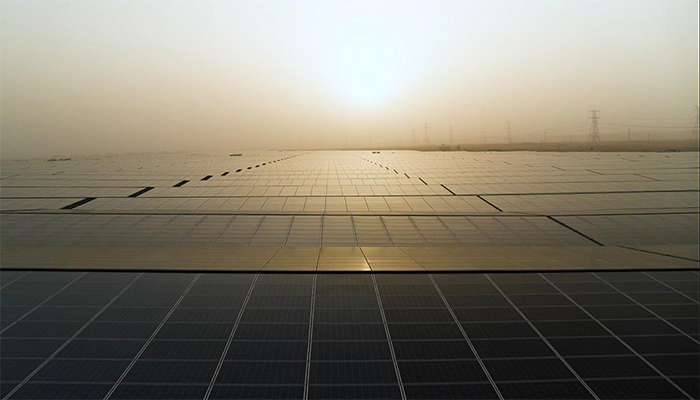
The current political landscape has seen Western nations scrambling to secure energy stocks, with much of this demand falling to the center East to provide, resulting in surging oil and gas prices that have created the type of seller’s market the globe has not seen in decades.
However, nobody for an instant believes that this can reverse the worldwide trend of weaning countries off hydrocarbon-based fuels.
Accordingly, there's a desire to hurry up the world energy transition to wash energy, namely renewables. The temperature change imperative is more menacing than ever, with scientists warning that it’s ‘now or never’ if we wish to limit the warming of the planet to 1.5 degrees.
With global investments in renewables, carbon capture technologies and green finance vehicles all on the increase, it’s clear that the energy transition remains uppermost within the minds of business and political leaders. As you'll be able to see from the solar news roundup below, this have to accelerate renewable energy generation could be a boon for solar, since it's one in all the foremost scalable renewable types.
Solar milestones and breakthroughs this month
Bahrain ups solar manufacturing muscle:
Bahrain’s current solar generation capacity may be a call the ocean for an island state where gas dominates its domestic energy mix. However, with reports that Bahrain’s oil reserves may dry out within the subsequent decade, diversifying its economy and energy provision capacity is crucial.Solar One, Bahrain's first solar panels company has boosted its capacity to provide 60,000 solar panels a year. These are mostly sold to Bahraini schools, homes or factories, to spice up domestic renewables. this can be a vital step in reaching the national target of renewables providing 5% of the country's energy supply by 2025.
Saudi Arabia – Modelling study shows solar panels could increase rainfall in arid regions:
As solar panels absorb sunlight and build solar power, they heat up. an enquiry team from the King Abdullah University of Science and Technology in Asian country have theorised that with an outsized enough solar installation, their combined heat is also enough to alter the reflectiveness of the land enough to strengthen sea breezes to the purpose that it'd dramatically increase rainfall within the surrounding area. While theoretical, this proof-of-concept study is of avid interest to geographic area governments, all of whom are battling the long-term challenge of water security. If proven, this might further boost the desirability of making large-scale solar installations, as they might produce clean energy while also creating much-needed freshwater supplies for parched regions.
Saudi Arabia – 1GW of solar investment packages awarded:
Faithful its energy strategy claims, Asian country is accelerating the initiation and deployment of recent solar installation projects. Together, the newest round of project tenders include the 80MW Layla solar PV IPP, the 120MW Wadi al-Dawassir solar PV IPP, and therefore the massive 700MW Al-Rass solar PV IPP. Investment within the largest of those proposed new solar facilities is estimated to be over $453 million.
Dubai – New tracker technology boosts solar production up to 30%:
Dubai’s Mohammed bin Rashid Al Maktoum Solar Park is expecting a productivity bump of virtually a 3rd, due to the utilization of the newest photovoltaic bifacial technology. along with a machine-learning based software algorithm, this technology allows solar panels to trace the sun and automatically position themselves to reap the foremost sunlight possible, regardless of the changing conditions in shade and diffused light throughout the day. MBRAMS Park remains the largest single solar installation within the world, currently producing 900MW of solar power, though its planned total capacity is ready to achieve 5,000MW by 2030.
California – Next-gen solar cells may make batteries obsolete:
California-based startup Ambient Photonics, and other key players, believe that new one-inch solar cells may hold the key to permanently replacing batteries in everyday household appliances. This new class of dye-sensitized solar cells (DSSCs) are capable of powering even sophisticated personal devices in indoor light conditions. If their efficiency and reliability levels are often proven to be high enough for widespread commercial use, this might solve a decades-old problem of waste related to disposable batteries.
Global – Rooftop solar installations may nearly double in next three years:
Analysis from Rystad Energy suggests that the world’s rooftop solar PV capacity may double to achieve 94.7GW by 2025. Ten years ago, rooftop solar was still a distinct segment development within the overall solar industry, because of the small scale of individual installations and general inefficiencies in how its harvested energy was added to the grid. Rystad’s report points towards friendly policies and incentives for the surge in rooftop solar adoption, as governments make it easier and more financially attractive for households and businesses to participate in solar power generation.
ME Solar boom is about for next five years
Even against the backdrop of surging oil and gas prices, the longer term of solar investment and development looks brighter than ever. Current events make it plain that that hydrocarbons will remain a necessary a part of the world’s energy mix for many years to come back, while also highlighting the hazards of overreliance on them.
The global energy transition could be a set course for overcoming both the political and environmental challenges related to energy security. Energy demand continues to soar worldwide, and therefore the Middle East’s natural response is to accelerate its destiny as a net exporter of alternative energy and expertise.
A report from Solar Power Europe points towards these factors, and others, because the foundation for a solar boom within the region over the following five years. With Saudi Arabia progressing to add 9.5GW by the top of next year, and Jordan and Egypt well positioned for timely solar capacity surges, it’s an exciting time to observe the industry thrive within the geographical region.